I’ll never forget the first time I stood before the Aztec Sun Stone in Mexico City's National Museum of Anthropology. It wasn't just its colossal size that was overwhelming; it was the intricate, almost chaotic, story carved into its surface. Our guide explained that this wasn't merely a calendar, but a dramatic cosmic map. At its heart was the face of a god, and surrounding him were symbols representing four cataclysmic destructions of the world. It was a visceral, real-world introduction to the aztec creation story, a narrative far more complex and cyclical than the linear creation myths I grew up with. That moment transformed my understanding of Aztec culture from a historical curiosity into a deeply philosophical worldview, one built on cycles of creation, destruction, and sacrifice. This article delves into that very legend: the Aztec creation story of the Five Suns.
Contents
- 1 The Foundation of the Aztec Creation Story: Duality and the Divine
- 2 The First Sun (Nahui-Ocelotl): The Jaguar Sun and the Aztec Creation Story
- 3 The Second Sun (Nahui-Ehecatl): The Wind Sun and the Aztec Creation Story
- 4 The Third Sun (Nahui-Quiahuitl): The Rain Sun and the Aztec Creation Story
- 5 The Fourth Sun (Nahui-Atl): The Water Sun and the Aztec Creation Story
- 6 The Fifth Sun (Nahui-Ollin): Our Current Era in the Aztec Creation Story
- 7 Frequently Asked Questions About the Aztec Creation Story
- 8 References
The Foundation of the Aztec Creation Story: Duality and the Divine
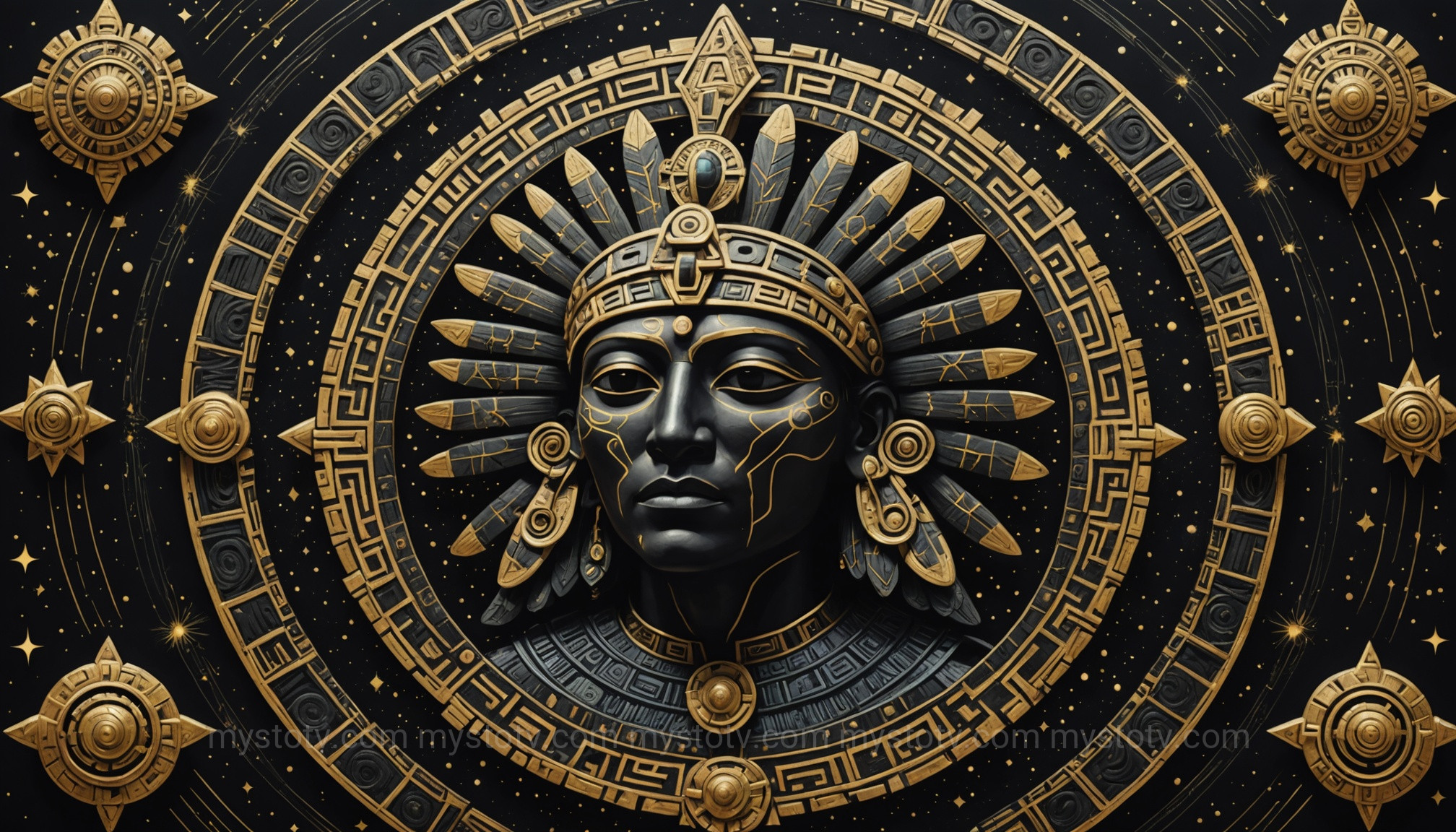
Before any suns rose or fell, the Aztec cosmos began with a concept fundamental to their entire worldview: duality. The universe was born from a single, dual god, Ometeotl, an entity that was simultaneously male and female, order and chaos, darkness and light. This progenitor deity, existing in Omeyocan, the "place of duality," embodied the idea that all existence is a balance of opposing forces. This core principle of the aztec creation story is not about good versus evil, but about the necessary tension between complementary opposites that drives creation forward.
From this primordial being, the universe unfolded. Ometeotl was not a god to be worshipped with temples and sacrifices; it was a philosophical absolute, the source of all that is. This concept of teotl—the sacred, divine energy that flows through the cosmos—is crucial to understanding the gods who would later shape the world.
Ometeotl: The Dual God at the Beginning of the Aztec Creation Story
Ometeotl, also known as "Two-God," was a compound of two aspects: Ometecuhtli (Two-Lord), the male essence, and Omecihuatl (Two-Lady), the female essence. They were the ultimate creative pair, self-created and existing beyond time and space. They were not active participants in the daily lives of humans but were the originators of the gods who would be. This initial phase of the Aztec creation story establishes that the universe is not a static creation but a product of an ongoing, dynamic process rooted in this fundamental duality.
The Four Tezcatlipocas: The Progenitor Gods of the Aztec Creation Story
Ometeotl gave birth to four sons, often called the Four Tezcatlipocas, who inherited aspects of their parent's dual nature and became the primary agents of creation and destruction. These gods were not simply allies; their constant struggle and rivalry are what propelled the cosmic cycle of the Five Suns. The four sons were:
- Xipe Totec (The Red Tezcatlipoca): The god of the East, associated with agriculture, spring, and renewal through suffering (the flayed lord).
- Huitzilopochtli (The Blue Tezcatlipoca): The god of the South, the fierce patron god of the Mexica people, associated with war, the sun, and human sacrifice.
- Quetzalcoatl (The White Tezcatlipoca): The god of the West, known as the "Feathered Serpent," associated with wind, wisdom, knowledge, and life.
- Tezcatlipoca (The Black Tezcatlipoca): The god of the North, the "Smoking Mirror," a powerful, unpredictable god of the night sky, sorcery, conflict, and change.
The epic rivalry, particularly between Quetzalcoatl and his brother Tezcatlipoca, becomes the central engine of the aztec creation story. Each sun, or world age, is created and presided over by one of these gods, only to be destroyed when their rivalry throws the cosmos out of balance.
The First Sun (Nahui-Ocelotl): The Jaguar Sun and the Aztec Creation Story
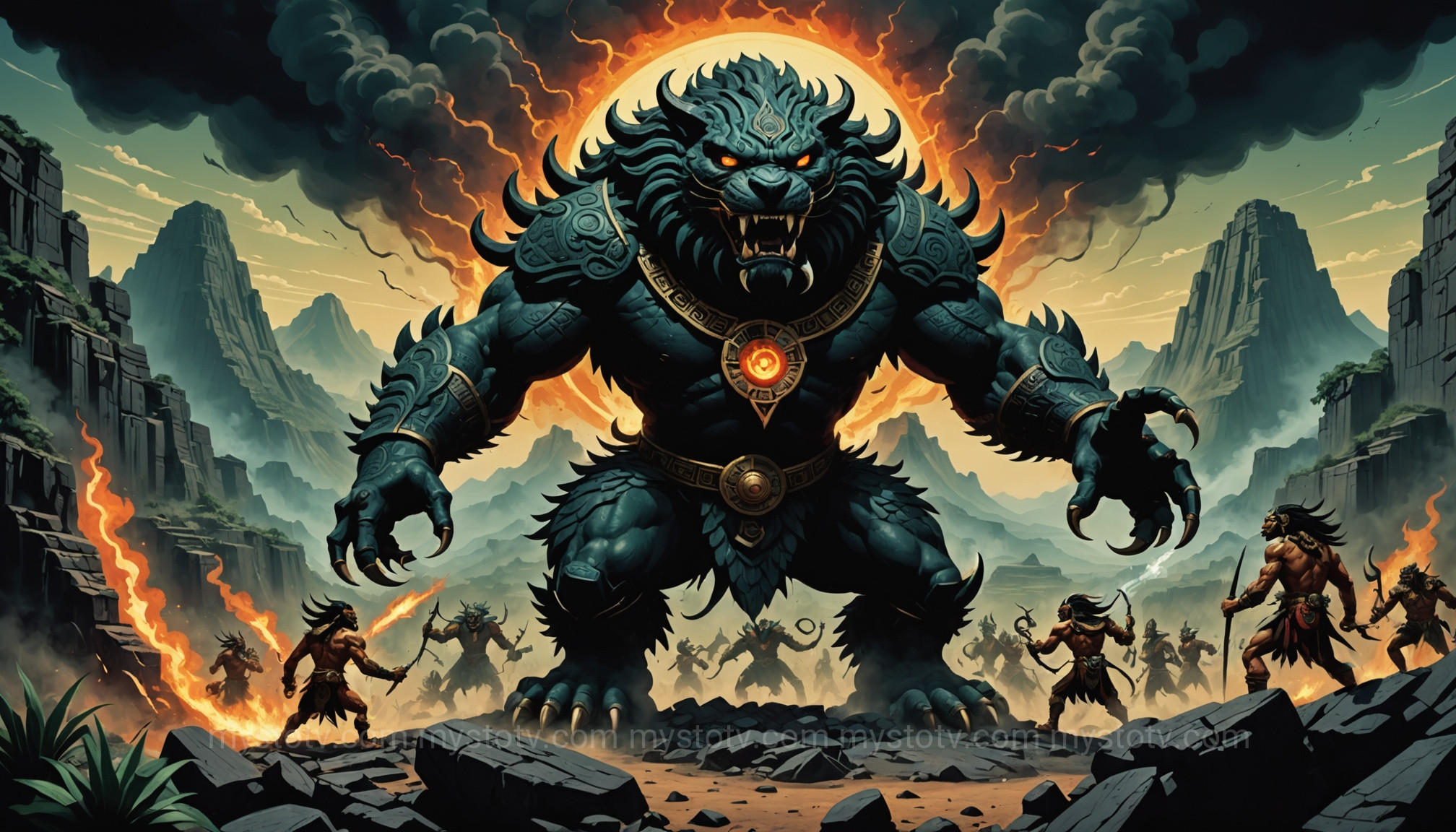
The first attempt at a stable world was presided over by Tezcatlipoca, the formidable lord of the Smoking Mirror. This era, known as Nahui-Ocelotl or "4-Jaguar," was lit by a dim, half-formed sun. The inhabitants of this world were giants, fashioned from ash, who lived on a diet of acorns. However, the world lacked perfection. The giants were clumsy, and the cosmic balance was precarious under Tezcatlipoca’s dark rule.
Eventually, the rivalry between the brothers boiled over. Quetzalcoatl, seeking a more perfect creation, struck Tezcatlipoca from the sky with a great club. Enraged and cast from his position as the sun, Tezcatlipoca transformed himself into a massive jaguar. In his fury, he, along with a host of other jaguars, descended upon the earth and devoured the giants, bringing the First Sun to a violent end. This part of the aztec creation story establishes a key theme: no creation is permanent, and divine conflict has world-ending consequences.
Analysis: The Jaguar Sun symbolizes a primitive, dark, and brutal beginning. The jaguar was a powerful nocturnal predator, representing the forces of the earth and the night sky—Tezcatlipoca's domain. The destruction by devouring highlights a raw, untamed power, setting the stage for the need for a more refined creation.
The Second Sun (Nahui-Ehecatl): The Wind Sun and the Aztec Creation Story
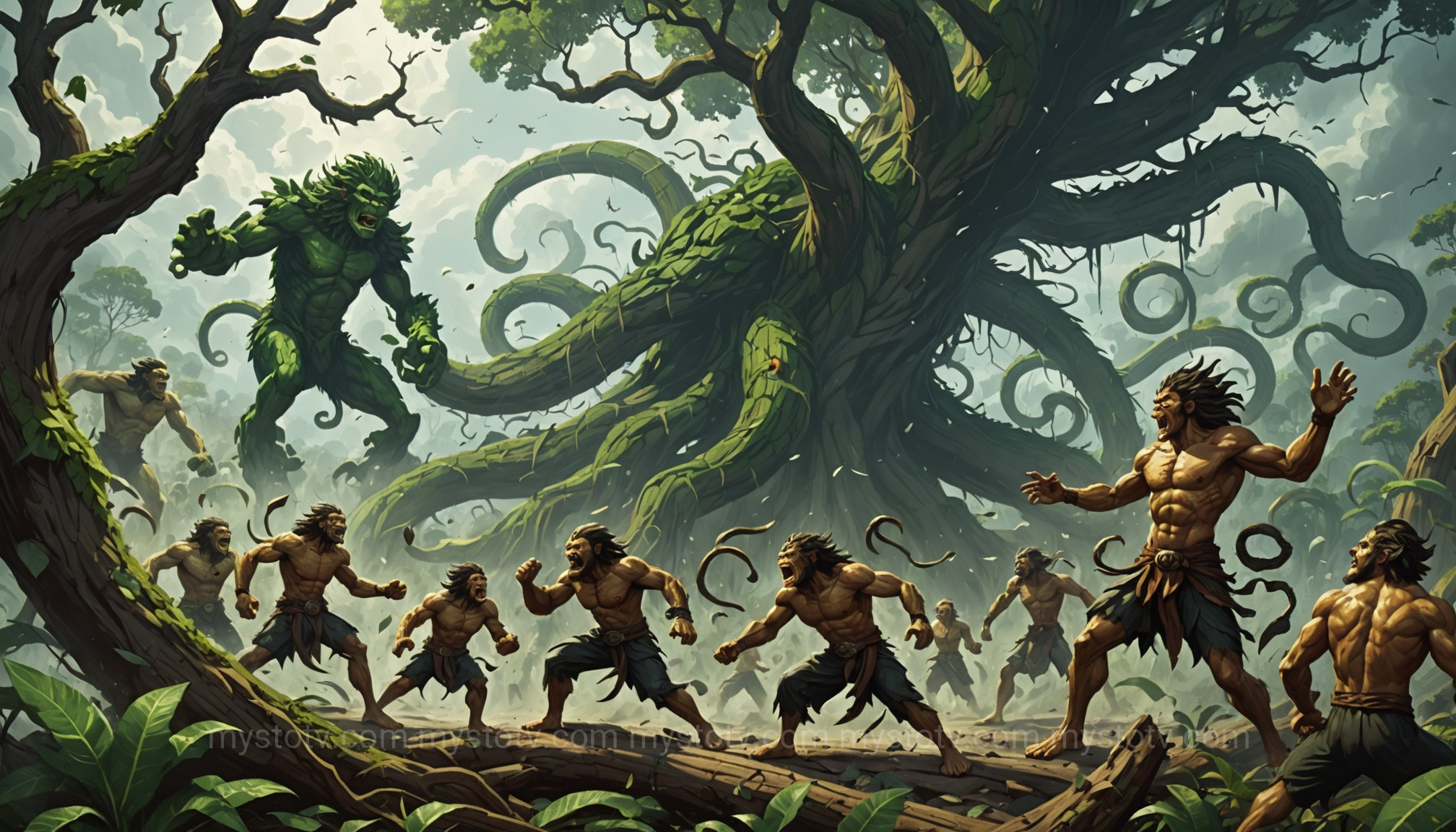
With Tezcatlipoca defeated, it was Quetzalcoatl's turn to rule. He created a new race of humans and became the Second Sun, Nahui-Ehecatl ("4-Wind"). The people of this age were less brutish than the giants and subsisted on pine nuts. For a time, there was a fragile order under the wise guidance of the Feathered Serpent.
However, Tezcatlipoca was not one to accept defeat. Driven by jealousy, he sought his revenge. He climbed a tree and, in an act of cosmic retribution, kicked Quetzalcoatl from his throne in the sky. As Quetzalcoatl fell, he unleashed catastrophic hurricanes and tempests that ravaged the world. The winds were so powerful that they swept away almost all the inhabitants. The few who survived were transformed into monkeys, a mocking reminder of their human-like form but lack of intellect and culture. This cyclical nature is a cornerstone of the aztec creation story.
Analysis: The Wind Sun represents an age of emerging culture and intellect, hallmarks of Quetzalcoatl. Its destruction by wind—an element also associated with Quetzalcoatl (in his form as Ehecatl)—is ironic. It suggests that even the elements of a creator god can become destructive when cosmic balance is lost. The transformation into monkeys serves as a mythological explanation for the existence of primates and a cautionary tale about a failed humanity.
The Third Sun (Nahui-Quiahuitl): The Rain Sun and the Aztec Creation Story
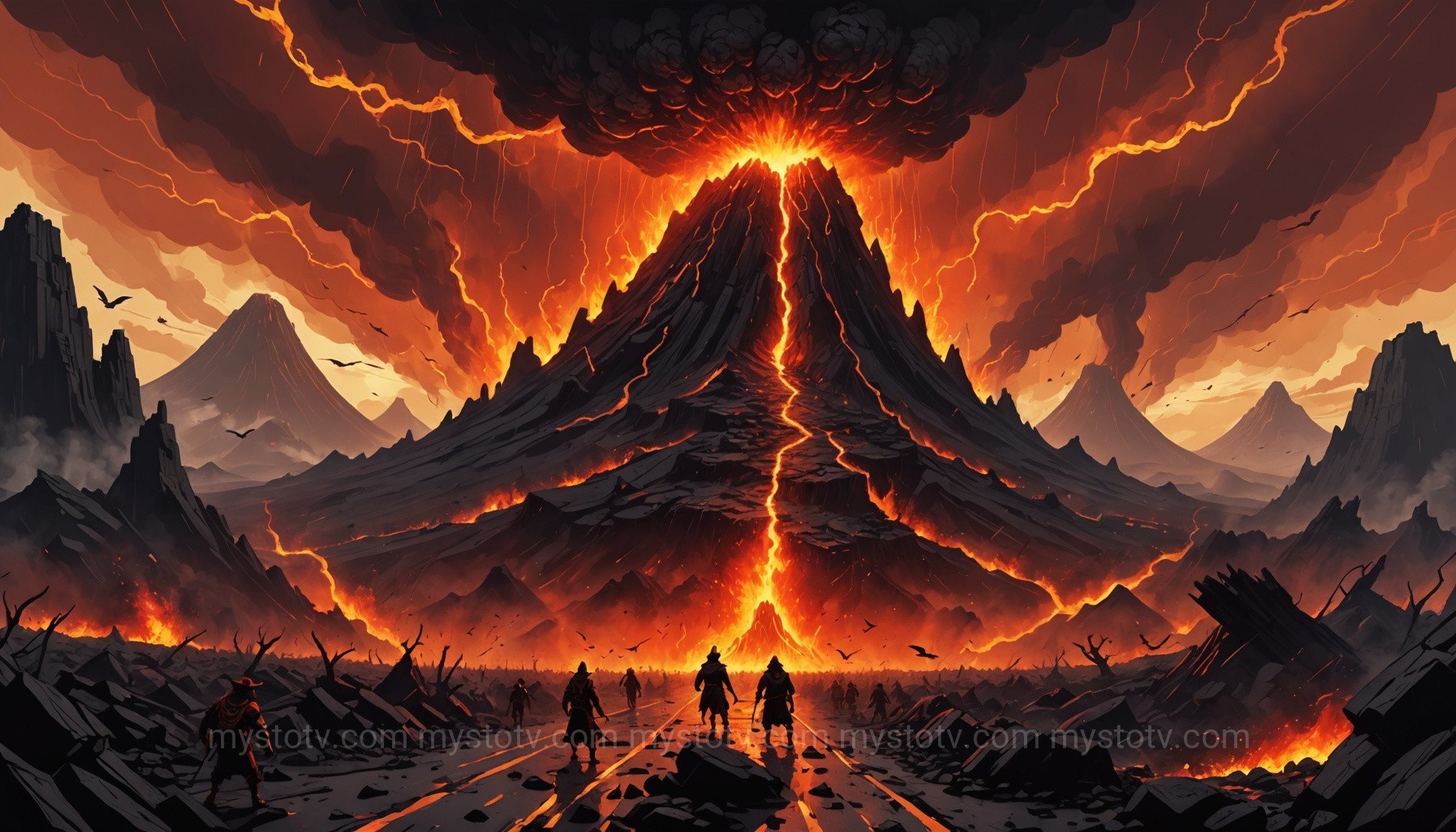
After the destruction of the Second Sun, the gods placed Tlaloc, the god of rain and water, as the ruler of the next age, Nahui-Quiahuitl ("4-Rain"). He created a new humanity that subsisted on a type of aquatic seed. Tlaloc was a vital deity for the agricultural societies of Mesoamerica, but his reign was also doomed by the ongoing divine drama.
This time, the conflict came from a more personal place. Tezcatlipoca, ever the agent of chaos, seduced Tlaloc's wife, the goddess Xochiquetzal. Consumed by grief and rage, Tlaloc neglected his duties and refused to provide the world with gentle, life-giving rain. Instead, he unleashed a torrential rain of fire and volcanic ash. The world burned, and in the chaos, the survivors were transformed into birds to escape the flames. The aztec creation story once again shows how the personal failings of gods have cosmic repercussions.
Analysis: The Rain Sun highlights the dual nature of essential elements. Rain, necessary for life, becomes a destructive force when corrupted by divine emotion. This mirrors the real-world experience of Mesoamerican peoples, who depended on rain but also feared droughts and violent storms. The transformation into birds is fitting, as they are creatures of the sky who can escape a world consumed by fire from below.
The Fourth Sun (Nahui-Atl): The Water Sun and the Aztec Creation Story
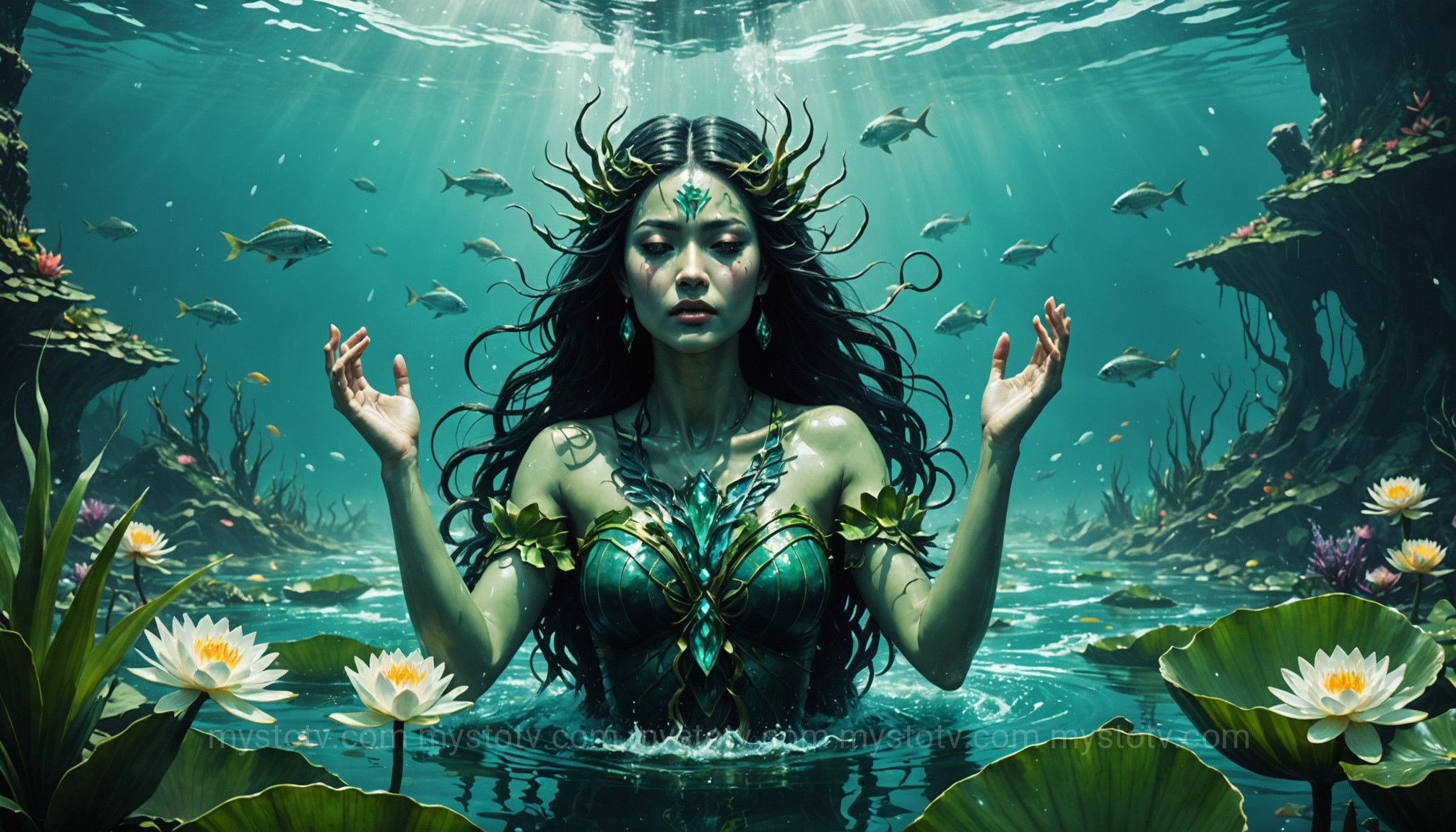
The fourth age, Nahui-Atl ("4-Water"), was presided over by Tlaloc's new consort, Chalchiuhtlicue, the "She of the Jade Skirt," goddess of lakes, rivers, and oceans. Humanity was remade and lived on a diet of maize, a significant step towards the food that would sustain the people of the final age. Chalchiuhtlicue was a nurturing goddess who cared deeply for her people.
Yet, the machinations of Tezcatlipoca continued. He accused the benevolent goddess of only pretending to be kind, filling her with despair. Heartbroken by the accusation, Chalchiuhtlicue wept for 52 years, and her tears became a cataclysmic flood that drowned the entire world. The mountains disappeared beneath the waves, and the sky itself collapsed onto the earth. To survive, the people of this age were transformed into fish. This narrative of a great flood is a powerful element of the aztec creation story.
Analysis: The story of the Water Sun resonates with flood myths from around the world but has a distinctly Aztec flavor. It's not a punishment for human sin but another result of divine conflict and emotion. The collapse of the sky is a critical detail, as it sets up the next major creative act: the raising of the heavens by Quetzalcoatl and Tezcatlipoca, who, for a brief moment, set aside their rivalry to restore cosmic order, transforming themselves into two great trees to hold up the sky.
The Fifth Sun (Nahui-Ollin): Our Current Era in the Aztec Creation Story
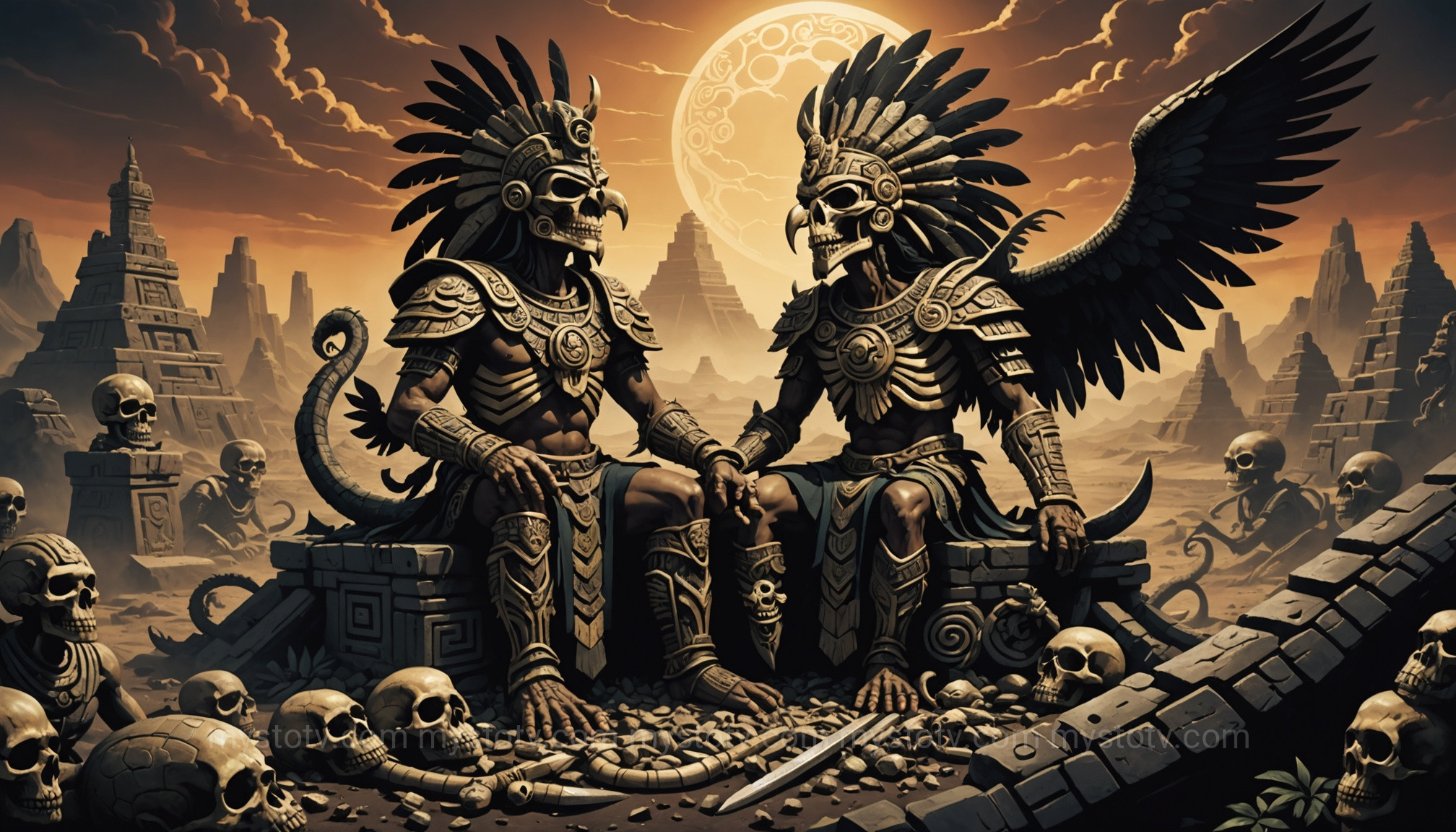
After four failed attempts, the world was a dark, empty, and water-logged place. The gods convened at the ancient, sacred city of Teotihuacan to decide how to create a final, definitive world—our world. This age, the Fifth Sun, known as Nahui-Ollin ("4-Movement" or "4-Earthquake"), is the most complex and significant part of the aztec creation story, as it explains the Aztec people's place in the cosmos and the profound reason for their rituals.
The Journey to Mictlan: Creating a New Humanity from the Aztec Creation Story
To create a new humanity, the gods needed a physical source. They decided to use the bones of the people from the previous age, which now lay in Mictlan, the underworld. Quetzalcoatl, the god of life, volunteered for the perilous journey. He had to trick Mictlantecuhtli, the fearsome lord of the dead, to retrieve the "precious bones." After a series of trials, Quetzalcoatl succeeded, snatching the bones and fleeing back to the world of the living. On his way out, he tripped and fell, shattering the bones into different-sized pieces—the mythological explanation for why humans are not all the same height.
The Sacrifice at Teotihuacan: Igniting the Sun in the Aztec Creation Story
Back at Teotihuacan, Quetzalcoatl and other gods ground the bones into a fine powder. They then performed an act of auto-sacrifice, letting their own blood onto the bone-meal to give it life. From this sacred mixture, the humanity of the Fifth Sun was born. But the new world was still dark. The gods agreed that one of them must sacrifice himself by leaping into a great bonfire to become the new sun. Two gods volunteered: the proud and wealthy Tecciztecatl, and the humble, pockmarked Nanahuatzin. Four times Tecciztecatl tried to jump into the flames, but his courage failed him. Then, Nanahuatzin, without hesitation, cast himself into the fire and was reborn as the sun. Shamed, Tecciztecatl followed, becoming the moon. The sun, however, did not move. It hung motionless in the sky, burning too brightly.
Humanity's Role: Sustaining the Fifth Sun in the Aztec Creation Story
The gods realized one final sacrifice was needed. To give the sun the energy to move across the sky, they all had to offer up their own lives. One by one, they were sacrificed, their hearts offered to the new sun, giving it the divine energy—tonalli—to begin its journey. This ultimate sacrifice set a profound precedent. The Fifth Sun, our sun, was born from the death of the gods. The aztec creation story thus imparts a critical responsibility to humanity: just as the gods sacrificed themselves for us, we must now feed the sun with our own precious energy (chalchihuatl, or "precious water," a metaphor for blood) to keep it moving and prevent the end of the world. This worldview justified the Aztec practice of ritual sacrifice as a cosmic duty, necessary to prevent the prophesied destruction of the Fifth Sun by earthquakes.
Frequently Asked Questions About the Aztec Creation Story
Exploring the legend of the Five Suns often leads to more questions about its context and interpretation. Here are answers to some common queries.
What is the significance of the Aztec Sun Stone in relation to the creation story?
The Aztec Sun Stone (Piedra del Sol) is a masterwork of Mesoamerican art and a direct physical representation of the aztec creation story. The face in the center is often identified as Tonatiuh (the sun god) or the earth monster Tlaltecuhtli. The four square panels surrounding the central face depict the glyphs for the four previous suns: 4-Jaguar, 4-Wind, 4-Rain, and 4-Water. The large "X" shape that frames these panels is the glyph for "Ollin," or movement, representing our current era, the Fifth Sun, fated to end by earthquake. It is therefore a visual summary of the entire cosmic myth, reinforcing the cyclical nature of time and the precariousness of the current age. This connects directly back to the Fifth Sun's creation.
How does the Aztec creation story differ from the Mayan Popol Vuh?
While both are complex Mesoamerican creation myths, they have key differences. The Mayan Popol Vuh focuses on the Hero Twins, Hunahpu and Xbalanque, and their journey through the underworld, Xibalba, to defeat the lords of death. The creation of humanity in the Popol Vuh involves several failed attempts (using mud, then wood) before succeeding with maize. The Aztec story, in contrast, is centered on the cosmic rivalry of the Tezcatlipoca brothers and the cyclical creation and destruction of four distinct worlds, each with a different sun and humanity. The theme of divine self-sacrifice to create the current sun is much more central and explicit in the Aztec narrative.
What does "Nahui-Ollin," the name of the Fifth Sun, actually mean?
Nahui-Ollin means "Four-Movement" or "Four-Earthquake." "Nahui" is the Nahuatl word for "four," and "Ollin" is a complex concept representing movement, change, and the cyclical nature of time. It is also the glyph for earthquake. The name is therefore a prophecy. It signifies that our current age is one of motion and life, powered by the sun's journey across the sky. However, it also contains the seed of its own destruction, foretelling that this world will come to a violent end through catastrophic earthquakes when the sun's energy finally runs out.
References
- León-Portilla, Miguel. Aztec Thought and Culture: A Study of the Ancient Nahuatl Mind. University of Oklahoma Press, 1963.
- Miller, Mary, and Karl Taube. An Illustrated Dictionary of the Gods and Symbols of Ancient Mexico and the Maya. Thames & Hudson, 1993.
- Smith, Michael E. The Aztecs. 3rd ed., Wiley-Blackwell, 2012.
- The Florentine Codex. Compiled by Fray Bernardino de Sahagún, 1545-1590.
- National Museum of Anthropology, Mexico. Sun Stone Exhibit Information. https://www.mna.inah.gob.mx/
The aztec creation story is more than a simple myth; it is a grand, cyclical epic that codifies a worldview. It explains not just how the world began, but why it is the way it is—precarious, balanced on a knife's edge, and dependent on the actions of humanity. The Legend of the Five Suns reveals a universe driven by divine conflict, redeemed by sacrifice, and sustained by a sacred duty. Understanding this powerful narrative is essential for appreciating the profound philosophical and religious convictions that shaped every aspect of Aztec civilization, from their temples and rituals to their art and their perception of time itself.